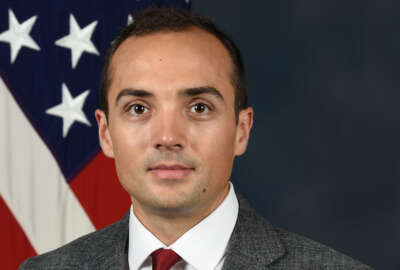This analyst says the Pentagon is so future-focused it’s forgetting the here-and-now
The U.S. military establishment is so focused on future technology that it risks national security right now. That's the thesis of my next guest. She argues an...
Best listening experience is on Chrome, Firefox or Safari. Subscribe to Federal Drive’s daily audio interviews on Apple Podcasts or PodcastOne.
The U.S. military establishment is so focused on future technology that it risks national security right now. That’s the thesis of my next guest. She argues an obsession with future, and futuristic, technology can lead planners off course. Joining the Federal Drive with more, the Brookings foreign policy fellow Amy Nelson.
Interview transcript:
Tom Temin: Ms. Nelson, good to have you in.
Amy Nelson: Hi, thanks so much for having me.
Tom Temin: And to be in studio that’s kind of exciting for us these days. So what are you saying we have this future command, we have all these OTA efforts going on to purchase new technologies? What’s the issue?
Amy Nelson: Sure. And that is no small feat, a long time coming. It’s good that we’re executing all these plans to improve procurement and partner with the private sector, and to stay on the cutting edge of technologies generally, and those with military applications specifically. The problem I think, is broader. It’s kind of a national obsession right now, a distraction of being consumed with what’s bright and shiny and coming over the horizon, instead of focusing on the planning that needs to happen for more imminent threats.
Tom Temin: Because they talk in military planning circles about the competitive edge or the offset. And they refer to some of the technologies developed that were revolutionary back in the 70s. Stealth seems old hat now, but it was really something hot and truly precision guided missiles and all of these things that everybody has now. And so how are they to tell what really could bear fruit in terms of the strategic offset in reality, versus what is just pie in the sky?
Amy Nelson: Yeah, that’s a great question, Tom. And one of the concerns I have related to this futurist obsession is that word offset, because we seem to be moving into a space of perpetual offset, which basically means technology driven arms racing. So who knows where that edge is? It’s hard to tell.
Tom Temin: But yet, you need an offset if you’re going to win.
Amy Nelson: In theory, but there are so many more variables to warfare now. So is it the fastest? Is it the most lethal? Is it the weapon that can travel farthest? It depends on the scenario. And it depends on a myriad of factors.
Tom Temin: Because they are developing, say, a new bomber right now. And who knows when that will actually fly or when it’ll be producible. Because I’m thinking of the adaption of an old airframe into a tanker. And that’s about 10 years late. And that was supposed to be just put a gas tank in a nozzle, and you’re all set to go. So is it also the fact that these things maybe never materialized? Is that part of the issue?
Amy Nelson: Look, technology innovation is hard. It’s a hard problem. And timelines are particularly difficult to nail down. Talk about struggling at predicting the future. We’re famously bad at estimating timelines to fruition. And there’s a lot of information out there about the timelines of future technologies, but they’re all guesstimates, essentially.
Tom Temin: And if you use the military say, to affect international affairs, maybe looking at Russia right now, which in many people’s opinion, is punching way above its weight as a country in terms of its economy and its population, its defense industrial base, and most of what they are going to Ukraine or next to Ukraine with, we don’t know at this point if they’re going to Ukraine is old platforms that have just been updated with technology. Sometimes it’s not even all that cutting edge, but it seems cutting edge and it adds up to something that has got the world on its toes.
Amy Nelson: Yeah. And does it even matter? Or is it just Russia’s willingness to use force relative to everyone else’s willingness to use force. An interesting aspect of that is that we actually have an arms control treaty that was explicitly designed to forestall the movement of those kinds of platforms and systems to border regions to create military surprise. So things don’t always work out as we plan for them to.
Tom Temin: All right, so how should the DoD think about the future? What’s a rational way to do it that does maintain deterrence? And, frankly, the ability as they say, to fight and win the nation’s wars?
Amy Nelson: Yeah, that’s a great question. I think it has a lot to do with understanding which threats are imminent, and which threats are likely and various combinations of those factors. So shouldn’t we already be preparing for the next pandemic? I don’t think we are. How about even the next wave of this pandemic? What does that preparation look like? And it’s about tough choices and trade offs and pushing policymakers to really act on urgent and imminent problems, even our nuclear force posture, are we just sticking with the same because the future is uncertain? Or does that warrant a more rigorous thinking about how we might use our nuclear weapons in a conflict today, not in the Cold War and not in the future?
Tom Temin: So that really is your first problem that you’ve listed in your essay about future obsession, as you call it is not preparing for what’s happening right now.
Amy Nelson: Exactly. And it’s a pervasive sentiment, we felt. It’s in DoD, it’s in defense planning. It’s coming out of Madison Avenue, and it’s all over social media and all the other forms of media we consume. And so the question was really like, is there an element of escapism happening here? Are we trying to escape a miserable present by sort of disappearing into a bright and flashy future?
Tom Temin: We’re speaking with Amy Nelson. She’s a fellow in the Foreign Policy Program at the Center for Strategy and Security and Technology at Brookings. And so what would you change about the whole process here? I mean, how do they, again, it’s a balancing, you can’t ignore the future?
Amy Nelson: Sure, absolutely. And there’s a lot that we say about decision making biases. And I think that the first step is really to be aware of the bias imposed by this kind of future obsession, and really trading off likely scenarios for kind of flashy ones.
Tom Temin: And you mentioned the drunkards search, where an obsession with a drunk trying to find his keys looks under the lamppost because that’s where the light is. You liken that to the nuclear war scenarios that were assumed in the post World War II era, the Cold War era, that there would be this massive, sudden and unexpected attack, which never did materialize.
Amy Nelson: Yeah. And yet those assumptions remained unquestioned for years. So now what is it? Is that the Terminator scenario we’ve all been fixated on for quite some time where there are good and bad robots, and that’s playing out on the battlefield, or maybe to some lesser extent, where automation is playing a bigger role? We have to make sure that science fiction isn’t biasing our thinking when we plan for the future.
Tom Temin: And also, I guess, understanding what is likely in the world. I asked one planner a number of years ago, I said, well, if China has a 5 million person army or something, I don’t know what they’ve got. And they were going to invade the United States. Shouldn’t we be prepared? I was kind of a question I didn’t really take seriously myself. He said, well it would probably take them five years to build up the capability to do that. So we would see that before it happened.
Amy Nelson: Absolutely, we really have to be on alert for all these kinds of indicators, especially when it comes to artificial intelligence, where there are so many unknowns about what our adversaries actually are innovating, how they’re integrating that into their military, and how they plan to operationalize it on the battlefield. So finding the right indicators to track that progress efficiently is going to be key.
Tom Temin: Because that kind of doctrine really is crucial, because the doctrine that starts at the top expands into different programs for the different armed services and for the fourth estate in defense. And that in turn translates into procurement programs and dollar allocations. And if you’re 1% off at the doctrinal level, then by the time you get to the spending level, you could be billions of dollars off.
Amy Nelson: Yeah, and myths are powerful, and fear is motivational. So if we’re afraid of being offset by another nation’s military, we’re likely to make a whole bunch of decisions that really skew those calculations.
Tom Temin: So how should planners then think differently from what they are now?
Amy Nelson: We need to think about a measured response and weighing contemporary scenarios, realistic scenarios, more proximal scenarios with the sort of pie in the sky, long term future scenarios. Should we be tracking how artificial intelligence is likely to impact operational level of conflict on the battlefield in the future? Absolutely. But we should really be doubling down on more imminent threats and concerns. What have we seen before that’s likely to be repeated? And that’s the stuff we don’t want to miss. That’s the stuff where there’s no excuse for missing.
Tom Temin: Because it seems like the most likely thing is not atom bombs falling from the skies so much as a cyber attack.
Amy Nelson: Exactly.
Tom Temin: And you got to give them credit for trying to be prepared for that. They talk about it enough.
Amy Nelson: Sure. And you know, there are cyber attacks all day, every day, it’s already here. So that’s absolutely more imminent concern, a more urgent concern, and let’s make the trade off, you know, against nuclear weapons, our planning and posture and let’s think hard about what the realities are.
Tom Temin: And finally, it sounds like you’re arguing that we should look beyond pure military threats from other nations as dangerous to our national security. Some people think the climate is one of those threats because of what it could do to facilities and cities and so forth. Is that a fair way to put it?
Amy Nelson: Yeah, definitely. Threats come in all forms. And we need to think more broadly about our most urgent threats. I know with the pandemic and climate change there are explicit Department of Defense implications of these threats, but they’re broader reaching than the Department of Defense, they affect the civilian population. And one might argue that those are the most urgent threats.
Tom Temin: So a more resilient society might need a less all-encompassing military. We have I saw the other day, one school district called in the National Guard to substitute teach in schools.
Amy Nelson: Wow.
Tom Temin: I thought we are really getting far down a road that probably we don’t want to be.
Amy Nelson: Yeah, that’s, that’s a great point and devastating. How do we make our society more resilient, but in a way that everyone doesn’t have to go it alone?
Copyright © 2024 Federal News Network. All rights reserved. This website is not intended for users located within the European Economic Area.
Tom Temin is host of the Federal Drive and has been providing insight on federal technology and management issues for more than 30 years.
Follow @tteminWFED







